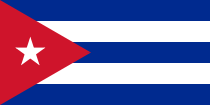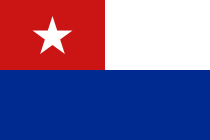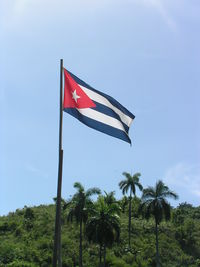Flag of Cuba
 |
|
| Use | National flag and ensign |
|---|---|
| Proportion | 1:2 |
| Adopted | May 20, 1902 |
| Designed by | Narciso López |
The flag of Cuba was adopted on May 20, 1902, containing a field with three blue stripes and two white stripes, and a red equilateral triangle at the hoist with a white 5-pointed star. The flag of Cuba was designed in 1848 for the liberation movement, which sought independence from Spain. The flag was briefly hoisted in 1850 at Cardenas but was not officially adopted until 1902, when independence was granted by the United States.
|
.svg.png) |
Birth of the flag

The Cuban flag was created by Narciso López in 1849, and put together by Emilia Teurbe Tolón. The Cuban flag's origins date from 1849, when various movements to liberate Cuba from Spanish rule emerged, mainly among Cuban exiles in the United States. Anti-Spanish Cuban exiles under the leadership of Narciso López adopted a flag suggested by the poet Miguel Teurbe Tolón. His design incorporates three blue stripes, representing the three parts that the country was divided during the independence wars, central, occidental, and oriental areas of the country, and two white stripes symbolizing the purity of the patriotic cause. The red triangle (triangle of masonic significance) stands for the blood shed to free the nation, which is placed where the star is, symbolizing the sky turned red from the blood shed in battle. The white star in the triangle stands for independence. López carried this flag in battle at Cárdenas (1850) and Playitas (1851). Although Lopez was not victorious, this was the first instance of the flag being raised in Cuba.
At the first independence war, the Ten Years' War, there was another flag in use, the "flag of Yara" also called "flag of La Demajagua"; while the one with the triangle and the stripes became the official Cuban flag, the Yara one is hoisted "wherever the legislators of the Cuban people meet"; in particular it is displayed, along with the national flag, in the National Assembly.
Subsequent use of the flag

In April 1869, Narciso Lopez's flag was designated the national banner by the Congress of the Republic of Cuba in Arms. Lopez's flag was the model for the flag of Puerto Rico adopted in 1892 by the Puerto Rican Revolutionary Committee, a pro-independence group that worked under the auspices of Cuban Revolutionary Party.
After the United States seized Cuba from Spain during the Spanish-American War, the Stars and Stripes flew from January 1, 1899, until independence was granted. On May 20, 1902, the Cuban national flag was hoisted as a symbol of independence and sovereignty. It has been used ever since, remaining unchanged after the Cuban Revolution of 1959. During the revolution, Cuban president Fidel Castro's 26th of July Movement created a party flag equally divided in red and black, usually in horizontal stripes and often with inscriptions, which is often flown on public buildings.
Symbolism in the Cuban flag
The Cuban government's current, official version of the meaning of the Cuban flag states that the blue stripes refer to the three old divisions of the island; and the two white stripes represent the strength of the independent ideal. The red triangle symbolizes equality, fraternity and freedom, as well as the blood shed in the island's struggle for independence. Finally, the white star is meant to symbolize freedom.
The flag of Cuba also influenced the design of the Estelada flag of the Catalan separatism movement; the numerous Catalan residents in Cuba during the independence process added a blue triangle with a white star to the national flag to design a battle flag for the independence movement in Catalonia.[1]
References
- ↑ Joan Crexell i Playà, L'origen de la bandera independentista, Edicions El Llamp, 1984.
External links
- Cuba at Flags of the World
- Cuba Flags — A historical insight into the flag and emblems of Cuba
|
||||||||||||||
|
||||||||
